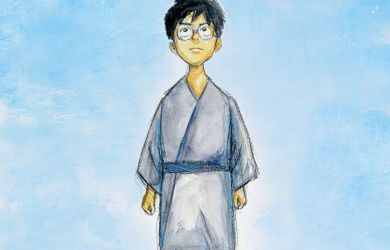
July 8, 2004
The Middle Way
Andrew McHugh embarks on a timeless pilgrimage in Tokyo’s tranquil backyard.
By Metropolis
Originally published on metropolis.co.jp on July 2004

Photos by Andrew McHugh
Saitama seems an unlikely spot to experience the historical and traditional aspects of Japan. But hidden in the hills and forests of Chichibu are some delightfully serene temples, 34 of which make up an old pilgrimage route popular during the Edo period with devotees of Kannon, the Buddhist deity of compassion.
These temples offer a breathtaking escape from the bustle of Tokyo, and can be visited on a number of leisurely day-trips. Those feeling a little more adventurous can walk, as I did, in the steps of ancient pilgrims from the first temple to the last in less than a week. At 100 kilometers from start to finish and with some moderate mountains and ridges to overcome, it requires effort and perseverance. But nature lovers, historical buffs, trekking enthusiasts, or those interested in temples or Buddhism, will surely find a great deal to their liking here.
Time travel
The tradition of pilgrimages in the Kanto area dates back to the Kamakura period (1185-1333) with the founding of a 33-temple route beginning in Kamakura and arriving in Tokyo’s Sensoji in Asakusa. The Chichibu Pilgrimage was established sometime after this and rose in prestige to become, along with the Kamakura-Tokyo and Kyoto-Nara routes, one of the three most important Kannon Pilgrimages. These walks were immensely popular and were undertaken by groups or individuals seeking a divine favor or blessing.

Nowadays, there’s not quite the same interest, and on a warm morning in May, I had the first temple to myself. Having waded through the Ikebukuro rush-hour madness only two hours before, I found the silent and timeless atmosphere of this temple surreal. The main hall had intricate wooden carvings sheltered beneath a large copper-green roof.
The building to the right housed a shop providing nokyocho (a book for collecting temple seals). The seals include beautiful calligraphic inscriptions painted by the monks and old-timers who maintain each temple, so by the time travelers reach the 34th they have a valuable and very personal keepsake. With my very own nokyocho in hand, I let go of all my stress, and took my first steps on the long walk.
On the trail
This first day’s journey wandered through villages, farmland and woodland, and to some pleasant temples imbued with a sense of antiquity and serenity. The locals contributed to the peacefulness as they slowly worked on small plots of land, taking the time to offer friendly greetings or to chat leisurely with their neighbors. The walk from the first temple to the second was a fairly taxing uphill trek through fragrant cedar woods, rewarded by a picturesque view of the valley down below. From there until the tenth temple, the going was easy and level, with the highlight being the popular fourth temple, known as Kinshoji, with its more than 1,000 stone statues, one of which is said to resemble every trekker on the route.
By the end of the first day I was able to experience some real Chichibu hospitality when an old man who had helped me with directions invited me to stay at his house. This was to become my base for the next three days with his wife providing me with breakfast, a bento and dinner every day. I was exceptionally fortunate since it had been my intention to camp, although there are plenty of ryokan (guest houses) along the way for weary walkers.

As luck would have it, my newfound friend was also a pilgrimage guide who outlined several points of pilgrim etiquette: Bow once when first entering the temple grounds. Light three incense sticks in the incense burner; these are an offering to the souls of the ancestors. Place a small coin in the money box and ring the gong. Bow three times, then say your prayer and bow three times again upon finishing. Finally, bow once more when leaving the temple grounds.
I repeated this ritual at every temple from the 11th to the 25th. Many of these are in and around Chichibu City, but from the 22nd temple onwards, I left the city behind to climb steadily past farms and through dense woods where countless flowers were in full bloom, and dramatic views of Mount Buko, the symbol of Chichibu, loomed in the background.
The 23rd temple is dedicated to music, displaying many pictures of enka singers who come to pray for successful careers. The 25th, Kyushyoji, is particularly scenic with a small wooden hall separated from the main building by a lake and surrounded by leafy trees.
The third day’s leg continued through pleasant forests and alpine pathways. Some temples were perched high in the mountains, serviced by stone steps rising steeply through pine woods. Others lay waiting at the bottom of cliffs, only revealing themselves through trees after a descent. The 28th temple stands on the site of a Yayoi period settlement (300 BCE-300 CE) near an eerie limestone cave with obscure, dripping stalactites and flitting bats. There’s even a temple displaying a “genuine” dragon skull.
Divine intervention
On the last day I took in the remaining two temples and a moderately strenuous hike up Mount Happu. This hike moves along the Fudatate Pass through a cedar forest and ends at the last temple, which emerges from in between the trees at the foot of the mountain.
Overcome by a sense of achievement, I stood in front of the quiet building surrounded by greenery and reflected on the last few days of walking. Energetic and reasonably slim trekkers can complete the pilgrimage with the traditional ritual of squeezing through a wet and narrow cave situated to the right of the main building. It’s a symbolic re-birthing—a sloughing off of one’s old self into a new life.
While the temples of Kyoto or Nara may be grander, many are overridden with crowds and commercialism. Chichibu’s pilgrim temples, which are still a part of the lives of the local people, offer a quieter, more personal and authentic experience. They also provide a chance to experience life at a slower pace and this is perhaps the essence of the walk—a timelessness away from the frantic pace and stress of city life.
Getting there
The Red Arrow Express (¥750/one-way) links Seibu Ikebukuro and Seibu Chichibu stations in approximately 1hr and 15min. Maps and directions to the temples and details of where to stay can be found in Sumiko Enbutsu’s guide, Chichibu: Japan’s Hidden Treasure, published by Tuttle.
Where to stay
The Chichibu Tourist Association (www.chichibuji.gr.jp, Japanese only) offers a comprehensive list of guesthouses sorted by area, as well as campsites and onsen.
[geo_mashup_map]





